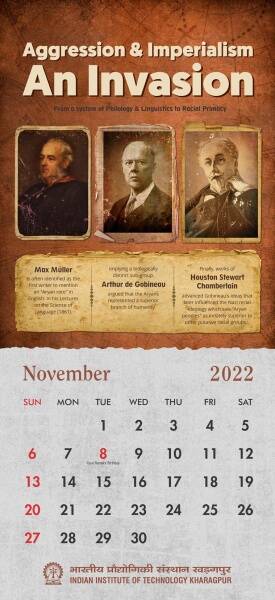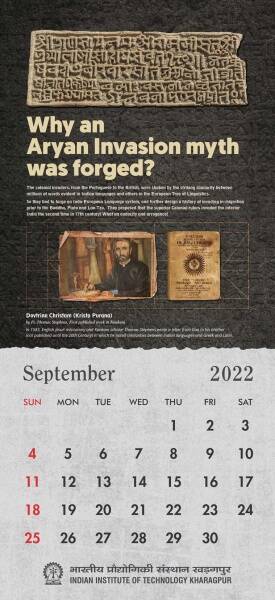Colonial and post-colonial leftist historians have erected the model of Indian chronology on false foundations.
New Delhi: Chronology is the backbone of history, archaeology, historical linguistics etc., what mathematics is to physical sciences. Ironically, world chronology adopted in the last 400 years by western historians believes in the Christian epoch of 1 AD as a sheet anchor, which has consequentially contracted all traditional chronologies of ancient civilisations by 660 years or more. Astonishingly, India’s colonial historians committed some serious mistakes over and above this, which led to the contraction of 1381 years of Indian chronological history.
The mistake arose since the early Syrian Christians were basing their Easter calculus on Indian Saka calendar and their misunderstanding of two epochs of ancient Indian eras—the old Saka era, which commenced in 583 BCE and the later Sakanta era (which also came to be known as Saka era) that commenced in 78 CE. Apart from this error, later Jain historians inadvertently identified Ujjain King Chandragupta, a disciple of Bhadrabahu, with the Maurya King Chandragupta, which made Mahavira, a contemporary of Buddha.
In reality, Buddha attained nirvana 675 years before the year of Mahavira nirvana. The Burmese and Sri Lankan inscriptions indicate that Buddha attained nirvana in 1864 BCE, if these chronological errors are corrected. Al Beruni, the noted Persian scholar, in his account clearly indicates that Buddha lived at least a few centuries before the birth of Zoroaster, but modern historians ridiculously teach us that Buddha was born after the death of Zoroaster. Recent excavations at Lumbini and the radiocarbon samples collected from the Trench C5 at the centre of the Buddhist shrine at Lumbini, which also has references to King Ashoka’s visit to it, indicate 1681 BCE as the date of the temple, implying Buddha’s nirvana was much earlier. Thus, there is a chronological error of 1,381 years in the dating of Buddha’s nirvana due to mixing up two different epochs of old Saka and later Saka eras and the mistaken identification of Chandragupta, the disciple of Bhadrabahu.

Owing to these blunders, historians repeatedly failed to reconcile the Buddhist, Jain and Puranic literary sources and epigraphic evidence. Consequently, colonial historians selected the foreign literary evidence of Sandrocottus-Alexander contemporaneity and the mistaken identification of Sandrocottus with Chandragupta Maurya as the sheet anchor of Indian chronology.
Evidently, colonial and post-colonial leftist historians have erected the model of Indian chronology on false foundations. Moreover, they have faithfully followed the Ussher chronology. The celebrated scientist Isaac Newton, in his book, “The Chronology of Ancient Kingdoms-Amended” was also under the hypnotic influence of the Ussher-Lightfoot chronology and adopted the date of creation of World by God as 4004 BCE (with a minor correction to 4000 BCE)—an absurdity—and the date of Jesus Christ (from 4 BCE) as 1 AD. He drastically revised the traditional timelines of various ancient civilisations without any failsafe evidence. To retrofit properly, he contracted the Greek chronology by 500 years and the Egyptian chronology by a thousand years because he found that the traditional chronology of Greece and Egypt was not consistent with reference to the Christian chronology i.e. Ussher-Lightfoot chronology. The scientist failed to apply his rational approach to examining the Ussher-Lightfoot chronology.
The epoch of 1 AD is simply not historically sustainable. No historian has ever produced an iota of independent evidence to establish the historicity of the epoch of 1 AD. Therefore, it cannot deserve to be the sheet anchor of world chronology.
Thus, there is a serious need to decolonise the chronology of Indian history by weeding out the mistakes committed by the colonial historians. Recently, IIT Kharagpur has designed a “Calendar 2022” as a rebuttal to the “Aryan Invasion/Migration Myth” and presented many evidences for the greater antiquity of Vedic civilisation. Reacting to this initiative of IIT Kharagpur, Tony Joseph, the author of “Early Indians” has advised to believe peer-reviewed studies, not calendar art and proclaimed that modern India is a result of mass migrations from Central Asian steppes. In fact, the so-called peers of Indian historical research are faithfully following the flawed model of chronology and have miserably failed to understand the antiquity of Indian civilisation beyond 1500 BCE. This fallacious chronological approach led to numerous dubious theories like Harappan civilisation as an extinct civilisation before the rise of the Indian civilisation, Aryan migration from the steppes etc. If the chronological error of 1381 years in the dating of Buddha is corrected, the speculative Aryan migration theory does not even deserve a mention in history books. Moreover, the mature Harappan period has to be chronologically placed before the Mahabharata era.
Traditional Indian chronology properly reconstructed based on multidisciplinary studies involving epigraphic, literary, archaeo-astronomical evidences and the sea level rise studies clearly indicates that Indian civilisation has been continuous since the beginnings of Holocene (Meltwater pulse 1A is dated around 12,700-11,500 BCE) and the Harappan civilisation was part of the Saka (Scythian) Empire that flourished before the Mahabharata era. The Sakas were an integral part of Indian society of Afghanistan and Pakistan region since the Vedic era and there were no mass migrations from the steppes to India around 2000-1500 BCE. Contrary to the steppe migration theory, actually, pre-Mahabharata migrations from India to Persia, Anatolia and East Europe led to the evolution of Indo-European languages and adoption of Indian calendars in those regions. For instance, the Hurrians (Mitannis) were the Shuras (Shura-Hura-Hurrian), who had migrated from Shorkot of Pakistan to Anatolia before the Mahabharata era.
Vedveer Arya is author of “The Chronology of India” (in three volumes) and “The Origin of the Christian Era: Fact or Fiction”

